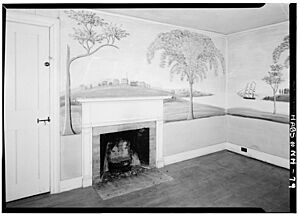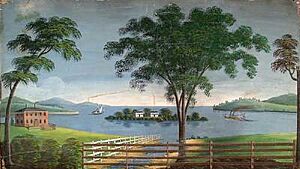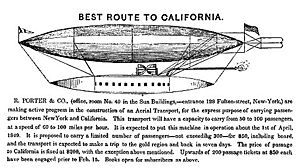Rufus Porter (painter) facts for kids

Rufus Porter (born May 1, 1792 – died August 13, 1884) was an amazing American artist, inventor, and the person who started Scientific American magazine. He was known for his many talents and creative ideas.
Contents
Early Life and Learning
Rufus Porter was born in West Boxford, Massachusetts. He was one of six children in his family. His parents were Tyler and Abigail Porter. Rufus began school when he was just four years old.
When Rufus was nine, his family sold their farm. They moved to Maine, settling in a place that is now part of Bridgton. At age 12, Rufus attended Fryeburg Academy for six months. In 1807, he started learning to be a shoemaker.
Family Life
In 1815, Rufus Porter married Eunice Twombly from Portland, Maine. They had ten children together. Some of their children included Stephen, Rufus King, and Nancy.
Later, in 1849, Rufus married Emma Tallman Edgar. They had six more children. Sadly, most of these children died when they were very young. Only one, Rufus Frank Porter, lived to be an adult.
Traveling Artist
By 1816, Rufus was living in New Haven, Connecticut. There, he taught dancing and started painting portraits. In 1818 and 1819, he traveled to the Pacific Northwest and Hawaii for trade.
After his travels, Porter returned to painting. He journeyed by coach and on foot, creating portraits across many states. These included New York, New Jersey, Maryland, and Virginia.
Painting Murals
Between 1825 and 1845, Rufus Porter became a very busy mural painter. He decorated about 160 homes and inns. His artwork could be found in Connecticut, Massachusetts, Maine, New Hampshire, Vermont, and even as far south as Virginia.
Porter's murals ranged from simple silhouettes to large scenes of towns or harbors. He brought his unique art all over New England. He often painted directly on dry plaster walls. He used a mix of freehand painting and stencils.
Some murals were full of color, while others used only one color. He even used a cork stopper to stamp in foliage instead of a brush! Often, he would also paint portraits of the family members living in the house.
Creative Inventions
Rufus Porter was an incredibly active inventor throughout his life. His obituary, a notice about his death, mentioned his many useful inventions. These included water wheels, windmills, and even flying machines. He also created devices to make farm work easier.
Published Ideas
In 1825 and 1826, he published a book called A Select Collection of Valuable and Curious Arts, and Interesting Experiments. He also built a portable camera obscura. This device helped him create silhouette portraits in less than 15 minutes. He charged only 20 cents for each one!
Porter experimented with many different inventions. He worked on a wind-powered mill, a washing machine, and a corn sheller. He also created a fire alarm, a rope-making machine, and a camera. His inventions also included clocks, railway signals, and a life preserver.
Missed Opportunities
Despite his many inventions, Porter often missed chances to make them successful businesses. For example, he invented the revolving rifle. However, he sold the rights to Samuel Colt for only $100. This design was then never used.
Founding Scientific American
In 1841, Rufus Porter bought a share in a magazine called the New York Mechanic. He published and edited this magazine in New York. The first issue came out on January 2, 1841. It focused on industry, enterprise, and scientific improvements.
After 23 weekly issues, Porter moved the magazine to Boston. He renamed it American Mechanic. In this magazine, he shared his plans for a rotary plow and a hot air ventilation system. He also advertised his patent agency, which helped people get patents for their inventions. This magazine lasted for 106 issues.
In 1845, he started a new weekly magazine called Scientific American. However, just 10 months later, he sold it to Orson Desaix Munn and Alfred Ely Beach. Today, Scientific American is still a very famous magazine!
Airship Dreams
In 1849, Porter had a big dream: to build a giant airship. It would be 800 feet long and powered by steam. He planned for it to carry 50 to 100 passengers. His goal was to transport miners to the California Gold Rush in just three days!
He had already built and flown several smaller models of his airship. He even advertised trips from New York to California. The fare was $200, with a $50 down payment. He started building his first "aeroport," which was 240 feet long. Sadly, a tornado destroyed it.
Later that year, he began building a 700-foot version with new supporters. But during a showing on Thanksgiving Day, excited visitors accidentally tore the hydrogen bag. This destroyed the airship. In 1854, his third attempt also faced technical problems and failed.
Later Life and Legacy
Rufus Porter passed away on August 13, 1884. He was at the home of his son, Rufus Frank Porter, in West Haven, Connecticut. He was buried in Oak Grove Cemetery in West Haven, Connecticut.
His obituary in Scientific American described his amazing and busy life. It noted that he lived through the terms of 21 American presidents. The magazine said that even though he might not be as famous as other inventors, Rufus Porter would be remembered. He was seen as a great example of how creative and versatile American inventors could be.
Writings by Rufus Porter
- 1825 A Select Collection of Valuable and Curious Arts, and Interesting Experiments
- 1849 Aerial Navigation: The Practicality of Traveling Pleasantly and Safely from New York to California in Three Days
Murals by Porter
- Birchwood Inn, Temple, New Hampshire
- Daniel Carr House, North Haverhill, New Hampshire
- Benjamin Cleaves House, Bridgton, Maine (Rufus Porter Museum)
- Eaton House, Bradford, New Hampshire
- Hancock Inn, Hancock, New Hampshire
- Kent House, Lyme, New Hampshire
- Prescott Homestead, Jaffrey, New Hampshire
- Reed Homestead, Townsend, Massachusetts
- Walter Russell House, Ashburnham, Massachusetts; part of the Cambridge Grant Historic District
- Mural House, Greene, Maine
- Damon Tavern, North Reading, Massachusetts





